FW
"The third day of Mercedes-Benz Fashion Week Russia started with the show by DARIA DASHINA. This unique Russian brand uses fine handcrafts and state-of-the-art technologies. Fall-Winter 2017/2018 collection offered trendy integrally knitted garments for both women and men. Specially for the latter DASHINA started a line of sweaters with large surface patterns and turtlenecks. Jersey elements of the ensemble and accessories are supplemented with suits made of natural fabrics and glossy sparkling dresses and skirts."

The third day of Mercedes-Benz Fashion Week Russia started with the show by DARIA DASHINA. This unique Russian brand uses fine handcrafts and state-of-the-art technologies. Fall-Winter 2017/2018 collection offered trendy integrally knitted garments for both women and men. Specially for the latter DASHINA started a line of sweaters with large surface patterns and turtlenecks. Jersey elements of the ensemble and accessories are supplemented with suits made of natural fabrics and glossy sparkling dresses and skirts. The designer used different technologies to entwine threads and to mix several colors in one garment for mélange and gradient effects. Main colors of this collection are black, white, red, blue, lilac and brown.
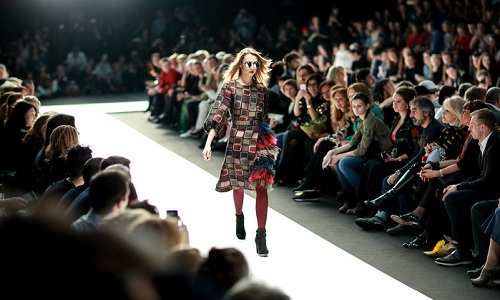
The collection «PH-XXXI» by YULIA KOSYAK was a real performance. The show started under the music background performed by WEREWOLFFAMILY Project. The designer uses leather, feathers and graphic images, parlaying personal touch and nontrivial texture combinations. Main colors of this collection are black with some green, beige, terracotta, brick-red and gold.
A Big-City Girl is always a hero. She arrests sights with her charming femininity, grace and trendy customized looks. In her FW17/18 collection KONDAKOVA offers her fans luxurious silhouette models, dresses and bombers, decorated jackets made of bouclé wool and cashmere, as well as zephyrian silk blouses.
YASYA MINOCHKINA revealed the inconsistency of the women’s nature. Romantic pencil pinafore dresses with gauze sleeves were harmonically supported by transparent below-knee skirts. Classic trenchcoats and cocoon overcoats were attenuated by basic T-shorts and sport bags. Lacquered leather and paillettes added some spice. The designer gave preference to big check and minutiae embroidered flowers that were supported with the overall color pallet with shades of sakura, violets and verbena.
Ekaterina Akkhuzina and EKATERINA FURS Fashion House presented the fur street-style collection. The designer experimented with the silhouettes and complicated pallets – sapphire, bright pink, orange with emerald-green, traditional brown. Massive graphic fur coats took turns with light pastel-shaded blue and delicate pink ones. Some of the challenging solutions were trendy rich-in-color puffer coats and fur biker jackets, as well as chevrons in pop-up style and strident inscriptions. The hero of this collection is a bold and epatage girl ready for new findings and adventures.
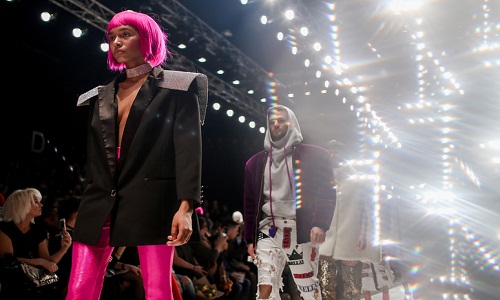
The Russian honored actress EVGENIYA KRYUKOVA made her debut with the women’s Fall-Winter collection in Mercedes-Benz Fashion Week Russia. Evgenia in love with delicate and thrilling lines of retro silhouettes combines them with current trends. Tucked and folded fabric, flounces, airy sleeves and trumpet skirts give a good showing of beautiful body shapes. Not only had the general cutout of garments reminded of the retro style. There were big polka dots, checks, bright citron and light beige colors, too. The designer boldly combined fabrics with different patterns in a single ensemble, caught on flower brooches and found new uses for imitation fur decorations.
GOGA NIKABADZE seemed to take the audience to the imperial environment of the East. The designer managed to combine comfort and authenticity with forethought and persistence. He offered velour pipestem pants, cotton shirts, cardigans and vests for men and gorgeous chiton-like floor-length shirt dresses for women. Uniqueness of this collection was emphasized with natural splendor of sandy, burgundy and sapphire shades.
In the presentation corner the provocative MyMokondo brand was presented that was established just about a year ago but has already won hearts of many fans. Eva Bogdanova, the designer, invented and patented erotic accessories to be put over underwear, outwear or on nude skin, so-called ‘straps’. The line has a great variety of straps like Aura, Shaula, Volans, Petra and many others, of different colors and width. MyMokondo boutique presents fetish accessories, leather masks, sword knots and chokers.
"Chinese market for yarn imports has seen a major shift due to two factors. One, lowering of price difference between international and domestic cotton this has made yarn imports less attractive. Further expansion of Xinjiang spinning capacity has made local yarn prices even more competitive due to cost advantages of spinning in Xinjiang. However, yarn imports would continue as still there is a gap in cotton availability in China vis-à-vis the demand. “So, yarn imports are here to stay but price competition would remain intense,” highlights Peter Dong, Birla Jingwei Fibres."

Chinese market for yarn imports has seen a major shift due to two factors. One, lowering of price difference between international and domestic cotton this has made yarn imports less attractive. Further expansion of Xinjiang spinning capacity has made local yarn prices even more competitive due to cost advantages of spinning in Xinjiang. However, yarn imports would continue as still there is a gap in cotton availability in China vis-à-vis the demand. “So, yarn imports are here to stay but price competition would remain intense,” highlights Peter Dong, Birla Jingwei Fibres.
Dealing with adverse situations
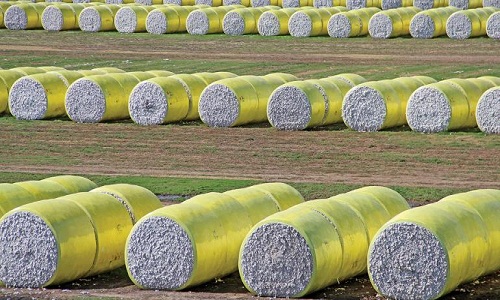
China being the dominant textiles market in the world is bound to have an impact on all international business in textiles, according to Dong. Due to increasing costs in China especially for cotton related products, China has shifted more and more to others fibres. Other markets like Vietnam and India are more competitive for Cotton yarns / fabrics now but they are still unable to match the scale and delivery capabilities of China.
“We as the largest viscose player in the world and are catering to specific niches in China market through our products Birla Modal and Birla Spunshades. Lot of yarn capacity in countries such as India, Pakistan etc, was added to serve China demand but with drop in attractiveness of China imports, it is creating extra competition in other parts of the world. At the end of the day, it is a global and interconnected market and China impacts rest of the world in a big way,” emphasises Dong.
Global outlook on cotton
Dong doesn’t expect global yarn production to increase by 3-4 per cent. Cotton yarn production is expected to grow by 2-3 per cent only whereas manmade cellulosic fiber yarns should grow by 6-7 per cent. “Bangladesh would be a growing market but he feels that more yarn needs to be converted to yarn and fabric within local markets itself rather than being exported. Exports are vulnerable to policy changes and government intervention in the form of duties. Vietnam and Indonesia have good spinning capabilities but lack domestic cotton. However, they can import cotton easily from good sources. Vietnam’s demand and supply dynamics in short to long term, as its domestic consumption is increasing. Vietnam has become a major yarn exporter now but that would change as local fabric production increases. Vietnam despite demise of TPP would remain an attractive textiles market in years to come” says Dong.
Expectations from Yarn Expo
“Yarn expo, March 2017 would be the first major textile industry event in Asia and we expect to see good participation from across the industry. 2016 was a volatile year but we finally saw yarn and fabric prices reverse the trend of falling prices and return to a more reasonable level. So, sentiment for 2017 and this event is broadly positive. Further, we expect to interact with our partners in downstream value chain so as to be geared up to meet their requirements in future. We would be mainly highlighting Birla Micro-Modal and Birla Spunshades fibers during this exhibition. While Micro-Modal meets the requirements of softness and addresses the trend towards finer and lighter fabrics.” Birla Spunshades addresses the issues of dyeing related pollution in the textiles industry. Both these products ideally fit the requirements of the industry and we would promote these during the show, remarks Dong.
“We are focussing on increasing visibility of viscose in the markets such as India through initiatives of Liva branding and Liva accredited partner forum. We are also upgrading our product mix towards more specialty fibres such as Modal and spunshades, which are meeting the needs of softness and resource conservation issues in textile industry,” concludes Dong.
"Cotton has predominantly been a volatile commodity and depends on many natural factors. It does impact on imports of yarn in China, yet niche buyers are always on buying table for good quality yarns and here Indorama has been having edge. Chinese knitting companies are large in size and look for big volumes of consistent quality. “Apart from huge local base, they look for Imports as well and demand has been fairly consistent from quality buyers."

Cotton has predominantly been a volatile commodity and depends on many natural factors. It does impact on imports of yarn in China, yet niche buyers are always on buying table for good quality yarns and here Indorama has been having edge. Chinese knitting companies are large in size and look for big volumes of consistent quality. “Apart from huge local base, they look for Imports as well and demand has been fairly consistent from quality buyers. Cotton seems to be going strong for the 2017-18 period and with depleting cotton stock in, the world is looking at China increasing its buying and expecting spike in cotton buying and interest from Hedge funds who are unfortunately controlling the commodity prices,” says Anil Tibrewal, PT Indorama Synthetics, Indonesia.
Global cotton outlook

With an increase in spindles in Xi’an and India, yarn production is increasing and so is demand. “At the end of the day, everything depends on fashion and final garment price. If brands decide to increase garment prices, threat from polyester which is all time low, may intervene and check. Bangladesh, China, Turkey and Egypt remain the largest markets for cotton yarn and readymade garments,” he says. Production base in Bangladesh is ever increasing backed by very low power and labour cost and availability of yarn locally.
China has many alternatives to India and Vietnam. “Duty free agreement will hurt Indian exports to China but domestic competition in India is hurting more than outside. Mere dependency on government subsidies to survive in cotton business needs to be checked with better infrastructure/port facilities, which I feel will improve in coming days after demonetization,” Tibrewal opines.
He says, TPP is important globally and its actual impacts are yet to be seen. “I am seeing positive factors as TPP could have been disastrous to textiles. Increased manufacturing in US with higher buying power may give a boost to overall textile trade. Manufacturing cost in textiles in US is not going to be cheaper either. They might still continue importing from across the border despite failed TPP and NAFTA as the cost of imports after adding the 20-25 per cent duty is still cheaper than local buying. Americans are used to larger margind contrary to Asians and would like to encash on this opportunity for quicker deliveries,” believes Tibrewal.
Promising prospects
Indorama is optimistic about the current situation of cotton business in China. In 2017, the trend is tilting towards cotton and cotton blended based products. Consumption is increasing and demand for good quality cotton yarn is on an upswing in China. “We are enjoying good buyer base in China. We are specialised with large production of 100 per cent combed compact contamination-free cotton yarns from Indonesia apart from virgin cotton open end yarns suitable for knitting. Above two products are not easily available and buyers are relishing the kind of quality we are shipping,” Tibrewal sums up.
"The second day of Mercedes-Benz Fashion Week Russia was opened with the show of KOMOD. Alain Nega presented her collection “Living In a Dream” giving the sense of tranquility and winging. Asymmetric floor-length dresses, exposed shoulders and low-cut necklines, basques and zephyrian translucent textures – this line of images is accomplished in somber colors: classic black, medium grey, powdery color with attractive silver accents."
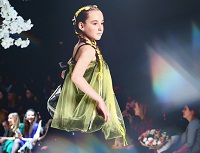
The second day of Mercedes-Benz Fashion Week Russia was opened with the show of KOMOD. Alain Nega presented her collection “Living In a Dream” giving the sense of tranquility and winging. Asymmetric floor-length dresses, exposed shoulders and low-cut necklines, basques and zephyrian translucent textures – this line of images is accomplished in somber colors: classic black, medium grey, powdery color with attractive silver accents. The evening gowns from "Flying Butterfly Collection" by Anastasia Mishina were all covered with butterflies, a well-known symbol of rebirth, reincarnation and freedom. All dresses were made of pieces of fabric that smoothly transformed into peculiar trendy images.
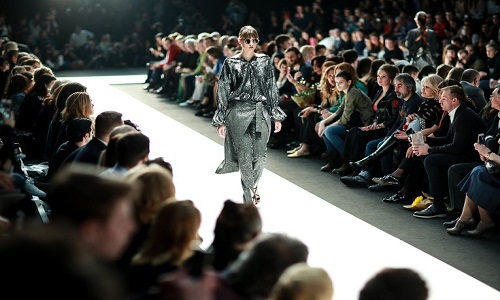
Femininity, elegancy and pageantry – this is all about the collection by BLUE JASMINE. The dresses both in shape and color reminded of morning rosebuds. The tenderness of the gowns was emphasized by translucent sleeves and veiling cascade skirts that advantaged in contrast with asymmetric jackets and heavy flower-embroidered dress trains. Boys were offered checked slacks with single color shirts and hats.
The women’s collection BGN styled by Alexandr Rogov is non-pretentious casual in restrained colors, without eye-catching or loud accessories. The collection included both formal images and cocktail and promenade gowns. Girls choosing BGN parlays individuality and comfort.
Fall/Winter 2017/18 by IVANOVA “The Lady / The Hooligan” embodies the ambiguity of the modern woman’s nature. The designer gallantly experiments with shapes and textures, and plays with various fabrics – moreen, tweed, knitted jersey and silk are used to create elegant shapes retaining the illusion of softness and lightness. The designer uses neutral shades of gray with some pink and jade.
The brand of wedding dresses Speranza Couture by NADEZDA YUSUPOVA presented transparent zephyrian dresses embroidered with crystals and laced flakes. This time the designer turned to tales of the East. She chose the shades of precious stones to color her collection up – amethysts, topazes, sapphires, morganites and diamonds. All the lines are traced with so much love to a woman’s body and the charming effect it provides on her chosen one. Low-cut necklines beautifully emphasize back and decolette zones, and trumpet skirts accent thighs and slim wastes. The ensemble is completed with luxurous embroidered trains. Novel and up-to-date images carry on the subject of eternal charm of love that inspires Nadezda.
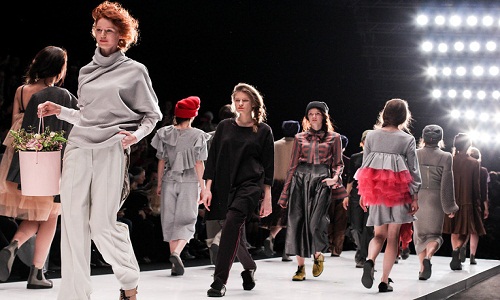
Ksenia Knyazeva was inspired by female omnitude. The hero of her collection, Jeanne d’Arc, embodied fragility and belligerency, transparency and enigma. This combination was presented in minimalistic slim-fit dresses, sweatshirts and wrapper coats finished with feathers and decorated with embroidered roosters. Formal long vests and culotte’s ensembles were attenuated with scandalous shirts, sword-knots, lacing and fishnet tights, adding some Gothics into the image. The Medieval theme was supported by aquarelle floral elements reminding of tinted glass.
Julia Dalakian presented her magical collection hypnotizing with its modest shimmering radiance. Deep copper and radiant metallic were complemented with paillettes and insolent inclusions like chains or fur bracelets emphasizing the model’s fragile vulnerability. There were also asymmetry, translucent and velvet fabrics and provocative bold cuts.
Consistent elegance expressed with simplicity and accuracy was the feature of the show by ISABEL GARCIA. This collection was a true berry cocktail. It started with embroidered rowanberries on formal suits and was followed by cranberry romantic A-line chiffon dresses. The final accord were clingy blackberry milk dresses and streamy skirts with cascade flounces.
All the collection by Bella Potemkina was made of Kanecaron modacrylic fibers that are used to make high quality eco-fur. The colors were bright and various – fuchsia and purple accompanied classic black and white, and the brand hero was bold, brave and ready to experiment. All images demonstrated deliberate negligence, easiness, sexuality and gloss. Cut-offs, bodysuits, over-knee boots, enameled leather, paillettes and double-breasted dresses – no superstitions, only bold visualization.
During Kazakhstan Fashion Week four brands presented their collections. The show started with evening gowns by AELITA. Besides relevant powdery, classic black and white colors there was languid raspberry. Multilayer flounces, trumpet and veiling skirts were a tribute to tendencies, whereas the brand surprised the audience with the variety of sleeve models and stunning corsets.
Minimalism, comfort and color coding are three pillars supporting the philosophy of DiSiitova. Pastel and sandy shades contrasted black and dark blue denim. Regular and pinafore dresses, overcoats and waist bags added new colorful layers and made complicated ensembles of simple elements. To go out in the evening the designer offered paillette dresses with slashed sleeves.
The collection by LIBАS Atelier celebrated youth and feminine charm. Fine organza dresses were covered with multiple flounces and drapes transforming into flowers and bouquets. The color palette repeated the ambience: brightness of fresh greens, transparency of brooks, first twilight shades.
ZHEREBTSOV presented bright street-style images, both brutal and dramatic. Metal was the main motive – clutch bags had chain handles, large studs decorated coat sleeves, shorts and knee-high socks. Metal elements contrasted red checked fabric and tie-dye denim. The designer used the classic epatage approaches like enlarged shoulders, guys dressed in fur coats and yellow shirts, zebrine trouser stripes.
In the presentation corner F.GENE, the St. Petersburg brand, demonstrated its hand-made eco-leather bags for tablets and notebooks. Light backpacks, shoulder bags and clutch bags were decorated with animalistic and geometric prints. In the brand’s Web-site the designer offers to make a personalized bag online – you can choose the length of handles, the color, the shape and the decorations.
"The global apparel fabrics and accessories industry is gathering in Shanghai on Wednesday for the Intertextile Shanghai Apparel Fabrics-Spring Edition 2017. The world’s largest trade event for the spring/summer season will host over 3,300 exhibitors from 26 countries and regions in seven halls of the National Exhibition and Convention Center until Friday. Intertextile Shanghai Apparel Fabrics-Spring Edition 2017 is co-organised by Messe Frankfurt (HK); the Sub-Council of Textile Industry, CCPIT; and the China Textile Information Centre."

The global apparel fabrics and accessories industry is gathering in Shanghai on Wednesday for the Intertextile Shanghai Apparel Fabrics-Spring Edition 2017. The world’s largest trade event for the spring/summer season will host over 3,300 exhibitors from 26 countries and regions in seven halls of the National Exhibition and Convention Center until Friday. Intertextile Shanghai Apparel Fabrics-Spring Edition 2017 is co-organised by Messe Frankfurt (HK); the Sub-Council of Textile Industry, CCPIT; and the China Textile Information Centre.

“With 2016 a challenging year for some in the industry, we found this fair became even more important for our international exhibitors and buyers as a key meeting place where business was still being conducted,” explains Wendy Wen, Senior General Manager, Messe Frankfurt (HK) and adds, “After strong growth in recent years, the current scale and quality of the fair, particularly with the industry-leading brands that both exhibit and source here, now makes this event an unrivalled business platform for the global industry to connect with the Chinese market, and vice versa.”
Major Attractions: International, Chinese pavilions, product zones
The quality of the fair’s offerings is widely evident in the International Hall (hall 5.2). The SalonEurope section will once again house the Milano Unica Pavilion, as well as the France and Germany Zones. In addition, Asian Pavilions from India, Japan, Korea, Pakistan and Taiwan, and Group Pavilions by Dyetec, Convergence Institute of Natural Materials and Lenzing feature alongside individual exhibitors from numerous countries.
To ensure ease of sourcing for buyers and increased exposure for exhibitors, key product groups are located in distinctive zones. In the International Hall, All About Sustainability, Functional Lab, Premium Wool Zone and Verve for Design feature the latest products, technologies and trends in these respective sectors, while Beyond Denim and Accessories Vision are in halls 6.2 and 8.1, respectively. Chinese exhibitors are grouped by product end-use in halls 6.1, 6.2, 7.1, 7.2, 8.1 and 8.2, with a number of regional and association pavilions also featuring throughout these halls.
Fringe Programs
Adding to the product diversity is the fair’s fringe programs, which feature a range of seminars and panel discussions along with four S/S 2018 trend forums: the Intertextile Directions Trend Forum (hall 5.2) and three Fabrics China Trend Forums for Fashion Focus (hall 7.2), suiting (hall 6.1) and ladieswear (hall 8.2). As well as Intertextile Shanghai Apparel Fabrics, four other textile fairs are also held concurrently at the National Exhibition and Convention Center: Yarn Expo Spring (hall 5.1), Intertextile Shanghai Home Textiles – Spring Edition (hall 4.2), CHIC (halls 1, 2, 3 & 4.1) and PH Value (hall 3).
Intertextile Shanghai Home Textiles-Spring Edition 2017
This fair is also happening concurrently at the National Exhibition and Convention Center (Shanghai) from March 15 to 17. Around 200 domestic and international exhibitors come together at hall 4.2 to showcase an impressive selection of finished products. These include: bedding, duvets, pillows, towelling, carpets, rugs and many more. Wen says, the success of last year’s Spring Edition proved their decision to recommence the fair was right, and demand in China for finished products at this time of the year grown. She expects the fair to be a great success this time round. Among the major highlights are the top industry leaders such as as Anhui Honren, Asahi Kasei, Cotton Council International, Zhejiang Hexin Holding, Jaspa Herington, Jiangyin Hongliu, Jihua 3542, Jinbaili, Lenzing AG among others exhibiting at the fair. Nine pavilions including one India and eight Chinese regional pavilions will exhibit their specialized products. Seven themes zones have been lined for different sourcing needs and to increase the business effectiveness of the fair. These include bedding and Interior Decoration Products Zone, Brand Bedding Products Zone, Towel Products Zone, Machinery Equipment Zone, Upholstery Fabrics Zone, Finished Curtains Zone and Designers’ Studio will host top suppliers of those sectors. Along with sourcing zones, the fair will host a Tmall to create valuable learning platform for the industry. Leading exhibitors will conduct a series of seminars to help educate the industry on latest consumer trends and product buying habits.
Korea is investing in Vietnam’s textile and garment industry in a big way. The move is to satisfy growing orders from US importers, mostly leading retailers such as Target, Walmart, Kohls, Kmart, Sears and Tesco. With more than 500 businesses based in Vietnam, and nearly $2 billion in total committed capital, Korean investment has helped bolster Vietnam’s textile and garment industry.
The Sea-A group has been operating in Vietnam for nearly six years and has a garment plant that turns out seven million products a year and has a workforce of 3,000. Korea is now Vietnam’s fourth largest export partner in terms of value, after the US, the EU and Japan.
Vietnam’s textile and garment exports to Korea have jumped sharply in recent years, from less than $300 million in 2009 to nearly $1.2 billion in 2013 and an estimated $750 million in the first five months of this year. This has given Vietnam’s textile and garments a 24.2 per cent market share in Korea, only behind China, with 43.2 per cent.
After the Asean-Korea free trade agreement Vietnam’s textile and garment industry saw significant growth. South Korea currently provides nearly 20 per cent of Vietnam’s textiles and with the large volume of ancillary materials it also exports.
At Technotex 2017, TTF will bring a delegation of eight of Taiwan’s top textile suppliers to ‘Taiwan Select’. Taiwan Select is being held by the Textile Export Promotion Project, commissioned by the Bureau of Foreign Trade. Taiwan Select will also provide sourcing support to buyers and manufacturers and provide industry information about Taiwan textile industry. The Taiwanese textile industry has developed environmentally-friendly concepts and done recycled polymer and polymer blends. From yarns for apparels to industrial and sport accessories, recycled yarns are growing in importance and are a core part of Taiwan’s textile industry.
Mixtures of new technologies and fashion allow new design elements that were hard to imagine in the past. Polymer based yarn developments in polyester, nylon, recycled and blended with natural fibers, lead the way. It is possible to have the look and feel of natural fiber fabrics with performance and flexibility of synthetics. Comfortable, breathable, wind and water resistant textiles are mixed and matched in breathtaking design elements. Odor control and a myriad of product enhancements allow new and innovative design directions bringing the consumer endless options.
The final piece of the Taiwan textile value equation is the vertical integration of many of its core textile suppliers into the finished garment business. Garments for yoga, outdoor, fleece and traditional woven apparel and knits of all types can be sourced directly with Taiwanese companies that have facilities in multiple international locations designed to deliver the quality and price needed. Taiwan brings a designed integrated flexibility in apparel from a group of innovative world class textile companies.
Sutlej Textiles and Industries clocked in a turnover of Rs 1,674 crores during the first nine months of the current financial year as compared to Rs 1,546 crores during the same period last year. Sutlej is into value-added dyed yarns and home textiles.
The company has undertaken an expansion project of 35,280 spindles for producing value-added cotton mélange and cotton blended dyed yarn. Sutlej will install 17 circular knitting machines by June next. Home textile capacity is being expanded to 9.6 million meters a year. An increased presence in the home textile segment will result in further strengthening Sutlej’s end-to-end operations – yarn to home textiles.
The company has also been continuously upgrading and modernizing its existing manufacturing facility. It has invested around Rs 49 crores during the first nine months of the current financial towards technology upgradation, debottlenecking etc. This will result in further improvement in efficiency and sustaining plant utilization.
The total spinning capacity of the company presently stands at 3,80,714 spindles. Sutlej has a strong global clientele and exports to more than 60 countries. The industry has seen a sharp increase in the cost of raw materials such as cotton and manmade fibers. Despite such adverse pressure on margins, Sutlej has been able to withstand the headwinds with full capacity utilization due to its diversified portfolio of value-added products.
For the quarter ended December 31, 2016, turnover for Nitin Spinners has gone up 30.34 per cent compared to the corresponding quarter of the previous year. Turnover for the nine months ended December 31, 2016, has increased by 12.43 per cent compared to the corresponding period in the previous year.
Nitin Spinners makes cotton yarn in single, multifold slub, compact, core spun and Elitwist yarns. The products are suitable for applications such as high value apparels and garments, undergarments, terry towels, denims, woven and medical fabrics, carpets, mattresses, stockings, furnishing fabrics and industrial fabrics.
The company caters to textile companies like Arvind, Raymonds, Alok, Bhaskar, Nandan, RSWM etc. About 65 per cent of the production goes to more than 50 countries across the globe including the US, Latin America, Middle East, Far East, European Union, Africa etc. The production capacity is 50,000 tons a year of cotton yarn and 8500 tons a year of knitted fabrics.
The company will be able to produce superfine compact premium yarns in the new facilities. During 2015-16, Nitin clocked a turnover of Rs 767 crores, out of which exports totaled Rs 531 crores. Operating profit before interest, depreciation and tax was Rs 137.76 crores and PAT was Rs 44.16 crores.
In financial year ’18, India’s share in the global textile and apparel trade could see an increase. This may happen given US’ exit from TPP and the likelihood of tax rationalisation under GST. Other helpful factors are strengthing of cotton production, cost and quality competitiveness due to increasing integrated fiber to apparel capabilities, the stimulus to exports, declining interest rates and a stable currency regime.
Meanwhile India’s exports of cotton yarn, both in terms of volume and value, dipped 11.6 per cent and 15.5 per cent during January to December 2016 compared to the corresponding period of the previous year. While December 2016 cotton yarn export volume grew 50.2 per cent, in value terms growth was only 20.1 per cent.
The drastic drop in the off take of cotton yarn by China has hurt Indian spinning industry. Inventory has been piling up and production in the powerloom, handloom and made-up sectors has come to a near halt.
The industry wants schemes like Merchandise Exports from India and Integrated Environmental Solutions to be extended for the benefit of cotton yarn as well. All other products in the textile value chain have been included in the list. It is felt that such extension to far-off destinations would help offset the high cost of transportation.











